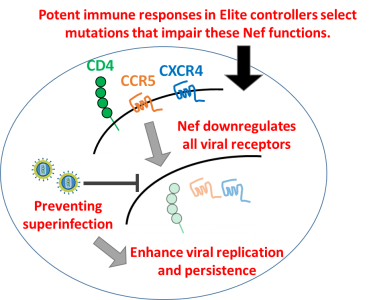Takamasa Ueno
Paper information
M Toyoda, Y Ogata, M Mahiti, Y Maeda, X Kuang, T Miura, H Jessen, B Walker, M Brockman, Z Brumme,
*T Ueno
Differential ability of primary HIV-1 Nef isolates to downregulate HIV-1 entry receptors. J Virol. 89, 9639-9652
doi:10.1128/JVI.01548-15
Highlights
- HIV-1 Nef plays a role in superinfection resistance by downregulating the viral entry receptors.
- Nef clones isolated from spontaneous viral controllers impair this activity.
- The functional impairment is mediated by immune-escape sites in the controllers.
Abstract
HIV-1 Nef down-regulates the viral entry receptor CD4 as well as the co-receptors CCR5 and CXCR4 from the surface of HIV-infected cells, leading to promotion of viral replication through super-infection resistance and other mechanisms. Nef sequence motifs that modulate these functions have been identified via in vitro mutagenesis of laboratory HIV-1 strains. However, it remains unclear whether the same motifs contribute to Nef activity in patient-derived sequences, and whether these motifs may differ in Nef sequences isolated at different infection stages and/or from patients with different disease phenotypes. Here, nef clones from 45 elite controllers (EC), 46 chronic progressors (CP), and 43 acute progressors (AP) were examined for their CD4, CCR5, and CXCR4 down-regulation functions. Nef clones from EC exhibited statistically significantly impaired CD4 and CCR5 down-regulation ability, and modestly impaired CXCR4 down-regulation activity, compared to those from CP and AP. Nef's ability to down-regulate CD4 and CCR5 correlated positively in all cohorts, suggesting that they are functionally linked in vivo. Moreover, impairments in Nef's receptor down-regulation functions increased the susceptibility of Nef-expressing cells to HIV-1 infection. Mutagenesis studies on three functionally-impaired EC Nef clones revealed that multiple residues, including those at novel sites, were involved in the alteration of Nef functions and steady-state protein levels. Specifically, polymorphisms at highly conserved tryptophan residues (e.g., Trp-57 and Trp-183) and immune-escape associated sites were responsible for reduced Nef functions in these clones. Our results suggest that the functional modulation of primary Nef sequences is mediated by complex polymorphism networks.

